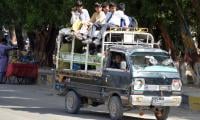ISLAMABAD: The Election Commission of Pakistan (ECP) Wednesday notified the determined seat share of the districts, agencies and Fata and Islamabad Capital Territory in the National Assembly and provincial assemblies on the basis of results of the Population Census, 2017.
The calculated shares, most of which are in decimals, have been rounded off to the nearest whole number. With a population quota of 667,193 persons per seat out of its 200,1579 population, the federal capital will have now three NA seats, whereas its adjoining district Rawalpindi with population quota of 780,266 persons, will have same seven NA seats, whereas with addition of two more, its tally of Punjab Assembly seats will now be 15 while its total population stands at 540,5633.
Sprawling Attock district, which borders Rawalpindi and Khyber Pakhtunkhwa, with a total of 188,3556 population and seat quota of 780,266 persons is set to lose one NA seat and will now have two seats, whereas its share in the provincial assembly will be six seats with an addition of one.
Lahore, the capital of Punjab will get five more provincial assembly seats after the fresh demarcation of constituencies, raising its rally from 25 to 30 besides an extra NA seat, as its population now hits 11.1 million figure. The share of seats is calculated by dividing 1100,17465 residents of Punjab by the 297 seats in the Punjab Assembly, yielding a per seat ratio of 370,412 people (same formula of total population and seats applies to other provinces and Fata regions). Lahore has a share of 30.03, which means it will pocket five additional provincial assembly seats now.
Gujrat with eight provincial assembly seats presently will lose two of them. Similarly, Faisalabad will lose one of its 22 seats. Jhelum will shed one seat and its seat share will now be three with its population quota share coming down to 3.30.
Similarly, Mandi Bahauddin with its share of 4.30 will lose one of its five seats. The number of seats in Okara will also come down from nine to eight against its share of 8.20. Khushab has a share of 3.45, reducing the number of its seats from four to three. Likewise, Sargodha presently holds 11 seats, will now lose one as its share comes to 9.99. Toba Tek Singh, currently with seven seats, has a share of 5.91, which only qualifies it for six. Muzaffargarh, Dera Ghazi Khan and Rajanpur will get one more PA seat each.
As many as eight districts, which include Faisalabad, Gujrat, Jhelum, Mandi Bahauddin, Okara, Khushab, Sargodha and Toba Tek Singh stand to lose a total of nine seats between them.
Sindh second most populated province with a population of 4789,3244, has 130 provincial assembly seats, making the per seat quota 368,354 persons. The port city Karachi’s six districts currently have 42 provincial assembly seats, but their collective share comes to 43.57, which means they are entitled to two additional seats.
Some districts including Naushehro Feroze and Shaheed Benazirabad; both have five seats each, but they are poised for losing one seat each.
In Khyber Pakhtunkhwa with a population of 3052,3371, Peshawar appears to be the largest beneficiary with its seat tally increasing from 11 to 14 PA seats. Moreover, Lower Dir with currently four seats, will also get one additional seat. Five KP districts, including Haripur, Abbottabad, Swabi, Chitral and Charsadda will lose one seat each on the basis of their share.
Balochistan now has a total of 1234,4739 and its capital Quetta with currently six seats, will pocket another three seats, taking its tally of seats to nine. Similarly, District Kech will witness an increase of one seat i.e. from three to four. Likewise, Khuzdar will also get one more PA seat, taking its share in the provincial assembly to three while sprawling Jaffarabad and Panjgur will lose one seat each. They currently have three and two seats respectively.
As per the Election Rules 2017, the delimitation of constituencies of an assembly will start from the northern end of the district, or, an agency, and will then proceed clock-wise in a zigzag manner, keeping in view that the population in the constituencies remain as close as was practicable according to the quota. Variation in population between two or more constituencies should not ordinarily exceed 10 per cent.
The six delimitation committees will record reasons if in exceptional circumstances the variation exceeds the limit. Any voter in a constituency may, within 30 days after the publication of preliminary proposals, make a representation to the commission in respect of delimitation of constituencies of the district or agency their vote is registered in.
A representation can be in the form of a memorandum giving the grounds for such representation and details of how constituencies of an assembly in the district or agency may be delimited if the representation was accepted by the commission. The entire exercise of delimitation of the constituencies will be completed by May 3.
The seat share has been worked out in pursuance of the Section 19 (1) and (4) of the Elections Act, 2017 read with Rule 8 of the Elections Rules, 2017.
PTI leader Azam Khan Swati. — The News/File ISLAMABAD: A local court on Tuesday confirmed the bail of PTI’s...
An exterior shot of the FIA headquarters. — Facebook/FileISLAMABAD: The Federal Investigation Agency , breaking a...
Sarhad Chamber of Commerce and Industry president Fuad Ishaq. — Facebook/Fuad Ishaq PESHAWAR: Sarhad Chamber of...
Sarfraz Bugti. — APP/FileQUETTA: Balochistan Chief Minister Sarfaraz Bugti has said that a committee is being formed...
Chairman Joint Chiefs of Staff Committee General Sahir Shamshad Mirza conferred civil awards to the eminent...
Former federal minister Fawad Chaudhary. — APP/FileMULTAN: Former Pakistan Tehreek-e-Insaf leader Fawad Chaudhry has...







